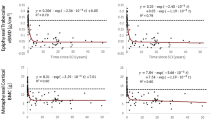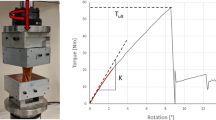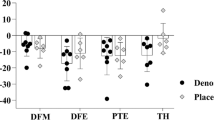Abstract
Summary
Computed tomography and finite element modeling were used to assess bone mineral and stiffness loss at the knee following acute spinal cord injury (SCI). Marked bone mineral loss was observed from a combination of trabecular and endocortical resorption. Reductions in stiffness were 2-fold greater than reductions in integral bone mineral.
Introduction
SCI is associated with a rapid loss of bone mineral and an increased rate of fragility fracture. The large majority of these fractures occur around regions of the knee. Our purpose was to quantify changes to bone mineral, geometry, strength indices, and stiffness at the distal femur and proximal tibia in acute SCI.
Methods
Quantitative computed tomography (QCT) and patient-specific finite element analysis were performed on 13 subjects with acute SCI at serial time points separated by a mean of 3.5 months (range 2.6–4.8 months). Changes in bone mineral content (BMC) and volumetric bone mineral density (vBMD) were quantified for integral, trabecular, and cortical bone at epiphyseal, metaphyseal, and diaphyseal regions of the distal femur and proximal tibia. Changes in bone volumes, cross-sectional areas, strength indices and stiffness were also determined.
Results
Bone mineral loss was similar in magnitude at the distal femur and proximal tibia. Reductions were most pronounced at epiphyseal regions, ranging from 3.0 % to 3.6 % per month for integral BMC (p < 0.001) and from 2.8 % to 3.4 % per month (p < 0.001) for integral vBMC. Trabecular BMC decreased by 3.1–4.4 %/month (p < 0.001) and trabecular vBMD by 2.7–4.7 %/month (p < 0.001). A 3.8–5.4 %/month reduction was observed for cortical BMC (p < 0.001); the reduction in cortical vBMD was noticeably lower (0.6–0.8 %/month; p ≤ 0.01). The cortical bone loss occurred primarily through endosteal resorption, and reductions in strength indices and stiffness were some 2-fold greater than reductions in integral bone mineral.
Conclusions
These findings highlight the need for therapeutic interventions targeting both trabecular and endocortical bone mineral preservation in acute SCI.



Similar content being viewed by others
References
Dauty M, Perrouin Verbe B, Maugars Y, Dubois C, Mathe JF (2000) Supralesional and sublesional bone mineral density in spinal cord-injured patients. Bone 27:305–309
Zehnder Y, Luthi M, Michel D, Knecht H, Perrelet R, Neto I, Kraenzlin M, Zach G, Lippuner K (2004) Long-term changes in bone metabolism, bone mineral density, quantitative ultrasound parameters, and fracture incidence after spinal cord injury: a cross-sectional observational study in 100 paraplegic men. Osteoporos Int 15:180–189. doi:10.1007/s00198-003-1529-6
Jiang SD, Dai LY, Jiang LS (2006) Osteoporosis after spinal cord injury. Osteoporos Int 17:180–192. doi:10.1007/s00198-005-2028-8
Biering-Sorensen F, Bohr HH, Schaadt OP (1990) Longitudinal study of bone mineral content in the lumbar spine, the forearm and the lower extremities after spinal cord injury. Eur J Clin Invest 20:330–335
Eser P, Frotzler A, Zehnder Y, Wick L, Knecht H, Denoth J, Schiessl H (2004) Relationship between the duration of paralysis and bone structure: a pQCT study of spinal cord injured individuals. Bone 34:869–880. doi:10.1016/j.bone.2004.01.001
Bravo-Payno P, Esclarin A, Arzoz T, Arroyo O, Labarta C (1992) Incidence and risk factors in the appearance of heterotopic ossification in spinal cord injury. Paraplegia 30:740–745. doi:10.1038/sc.1992.142
Chen Y, DeVivo MJ, Roseman JM (2000) Current trend and risk factors for kidney stones in persons with spinal cord injury: a longitudinal study. Spinal Cord 38:346–353
Vestergaard P, Krogh K, Rejnmark L, Mosekilde L (1998) Fracture rates and risk factors for fractures in patients with spinal cord injury. Spinal Cord 36:790–796
Garland DE, Adkins RH (2001) Bone loss at the knee in spinal cord injury. Top Spinal Cord Inj Rehabil 6:37–46
Rogers T, Shokes LK, Woodworth PH (2005) Pathologic extremity fracture care in spinal cord injury. Top Spinal Cord Inj Rehabil 11:70–78
Morse LR, Battaglino RA, Stolzmann KL, Hallett LD, Waddimba A, Gagnon D, Lazzari AA, Garshick E (2009) Osteoporotic fractures and hospitalization risk in chronic spinal cord injury. Osteoporos Int 20:385–392. doi:10.1007/s00198-008-0671-6
Biering-Sorensen F, Bohr HH, Schaadt OP (1988) Bone mineral content of the lumbar spine and lower extremities years after spinal cord lesion. Paraplegia 26:293–301
Garland DE, Stewart CA, Adkins RH, Hu SS, Rosen C, Liotta FJ, Weinstein DA (1992) Osteoporosis after spinal cord injury. J Orthop Res 10:371–378. doi:10.1002/jor.1100100309
Dudley-Javoroski S, Shields RK (2010) Longitudinal changes in femur bone mineral density after spinal cord injury: effects of slice placement and peel method. Osteoporos Int 21:985–995. doi:10.1007/s00198-009-1044-5
Frotzler A, Berger M, Knecht H, Eser P (2008) Bone steady-state is established at reduced bone strength after spinal cord injury: a longitudinal study using peripheral quantitative computed tomography (pQCT). Bone 43:549–555. doi:10.1016/j.bone.2008.05.006
Rittweger J, Goosey-Tolfrey VL, Cointry G, Ferretti JL (2010) Structural analysis of the human tibia in men with spinal cord injury by tomographic (pQCT) serial scans. Bone 47:511–518. doi:10.1016/j.bone.2010.05.025
Edwards WB, Schnitzer TJ, Troy KL (2013) Bone mineral loss at the proximal femur in acute spinal cord injury. Osteoporos Int. doi:10.1007/s00198-013-2323-8
Edwards WB, Schnitzer TJ, Troy KL (2013) Torsional stiffness and strength of the proximal tibia are better predicted by finite element models than DXA or QCT. J Biomech. doi:10.1016/j.jbiomech.2013.04.016
Winter DA (1990) Biomechanics and motor control of human movement. John Wiley & Sons, New York
Marshall LM, Lang TF, Lambert LC, Zmuda JM, Ensrud KE, Orwoll ES, Osteoporotic Fractures in Men (MrOS) Research Group (2006) Dimensions and volumetric BMD of the proximal femur and their relation to age among older U.S. men. J Bone Miner Res 21:1197–1206. doi:10.1359/jbmr.060506
Lang T, LeBlanc A, Evans H, Lu Y, Genant H, Yu A (2004) Cortical and trabecular bone mineral loss from the spine and hip in long-duration spaceflight. J Bone Miner Res 19:1006–1012. doi:10.1359/JBMR.040307
Rho JY, Hobatho MC, Ashman RB (1995) Relations of mechanical properties to density and CT numbers in human bone. Med Eng Phys 17:347–355
Dalstra M, Huiskes R, Odgaard A, van Erning L (1993) Mechanical and textural properties of pelvic trabecular bone. J Biomech 26:523–535
Keyak JH, Rossi SA, Jones KA, Les CM, Skinner HB (2001) Prediction of fracture location in the proximal femur using finite element models. Med Eng Phys 23:657–664
Rho JY (1996) An ultrasonic method for measuring the elastic properties of human tibial cortical and cancellous bone. Ultrasonics 34:777–783
Gray HA, Taddei F, Zavatsky AB, Cristofolini L, Gill HS (2008) Experimental validation of a finite element model of a human cadaveric tibia. J Biomech Eng 130:031016. doi:10.1115/1.2913335
Cody DD, Gross GJ, Hou FJ, Spencer HJ, Goldstein SA, Fyhrie DP (1999) Femoral strength is better predicted by finite element models than QCT and DXA. J Biomech 32:1013–1020
Crawford RP, Cann CE, Keaveny TM (2003) Finite element models predict in vitro vertebral body compressive strength better than quantitative computed tomography. Bone 33:744–750
Hansen U, Zioupos P, Simpson R, Currey JD, Hynd D (2008) The effect of strain rate on the mechanical properties of human cortical bone. J Biomech Eng 130:011011. doi:10.1115/1.2838032
Ito M, Matsumoto T, Enomoto H, Tsurusaki K, Hayashi K (1999) Effect of nonweight bearing on tibial bone density measured by QCT in patients with hip surgery. J Bone Miner Metab 17:45–50
Rittweger J, Simunic B, Bilancio G, De Santo NG, Cirillo M, Biolo G, Pisot R, Eiken O, Mekjavic IB, Narici M (2009) Bone loss in the lower leg during 35 days of bed rest is predominantly from the cortical compartment. Bone 44:612–618. doi:10.1016/j.bone.2009.01.001
Eser P, Frotzler A, Zehnder Y, Denoth J (2005) Fracture threshold in the femur and tibia of people with spinal cord injury as determined by peripheral quantitative computed tomography. Arch Phys Med Rehabil 86:498–504. doi:10.1016/j.apmr.2004.09.006
Ausk BJ, Gross TS (2012) Metaphyseal and diaphyseal bone loss following transient muscle paralysis are distinct osteoclastogenic events. Proceedings of the American Society of Biomechanics 36th Annual Meeting; 2012 Aug 15–18, Gainesville, FL. http://www.asbweb.org/conferences/2012/abstracts/200.pdf
Prevrhal S, Engelke K, Kalender WA (1999) Accuracy limits for the determination of cortical width and density: the influence of object size and CT imaging parameters. Phys Med Biol 44:751–764
Centers for Disease Control and Prevention (2010) Spinal cord injury (SCI): fact sheet. http://www.cdc.gov/traumaticbraininjury/scifacts.html. Accessed 6 September 2012
Acknowledgments
The authors thank Danielle Barkema, M.S., Meghan Lipowski, and Narina Simonian for their help with subject recruitment and data collection. This project was funded in part by an investigator-initiated research grant from Merck & Co, Inc. to TJS and KLT.
Conflicts of interest
None.
Author information
Authors and Affiliations
Corresponding author
Rights and permissions
About this article
Cite this article
Edwards, W.B., Schnitzer, T.J. & Troy, K.L. Bone mineral and stiffness loss at the distal femur and proximal tibia in acute spinal cord injury. Osteoporos Int 25, 1005–1015 (2014). https://doi.org/10.1007/s00198-013-2557-5
Received:
Accepted:
Published:
Issue Date:
DOI: https://doi.org/10.1007/s00198-013-2557-5




